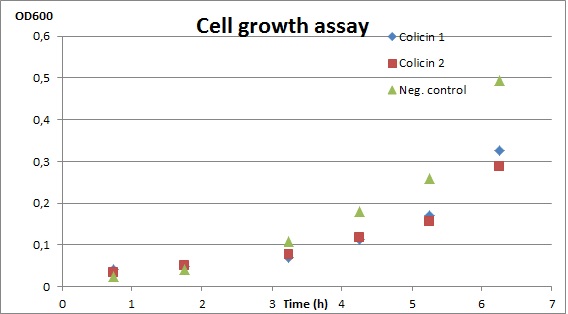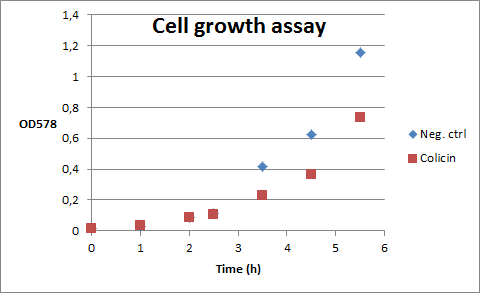Difference between revisions of "Part:BBa K822002"
| Line 2: | Line 2: | ||
<partinfo>BBa_K822002 short</partinfo> | <partinfo>BBa_K822002 short</partinfo> | ||
| − | Coding sequence for the channel-forming protein Colicin E1 of E. coli and its associated immunoprotein. | + | Coding sequence for the channel-forming protein Colicin E1 of E. coli and its associated immunoprotein. Colicins are. Colicins have been researched for use as food preservatives and in treating disease due to their This part is derived from <partinfo>BBa_K150007</partinfo>. |
| − | + | ||
| Line 24: | Line 23: | ||
==References== | ==References== | ||
| − | [1]: "Applications and Mechanisms of Colicin E1", Brenda Sue Patton, 2007. | + | [1]: "Applications and Mechanisms of Colicin E1", Brenda Sue Patton, Ph.D. Thesis - Iowa State University, 2007. ISBN 0549357262. |
<!-- Add more about the biology of this part here | <!-- Add more about the biology of this part here | ||
Revision as of 14:12, 26 September 2012
Colicin E1 + immunoprotein
Coding sequence for the channel-forming protein Colicin E1 of E. coli and its associated immunoprotein. Colicins are. Colicins have been researched for use as food preservatives and in treating disease due to their This part is derived from BBa_K150007.
Testing
The part was placed under a constitutive promoter and cell growth experiments performed to determine if cell growth would be inhibited in samples treated with lysate of the cells containing the part. Experiments showed a delayed response with differences between those samples treated with lysate from the putative colicin-producing cells and those treated with lysate from a negative control being apparent after about 3 hours.
Cells containing the colicin part in an ampicillin resistant plasmid were added to a culture containing ampicillin and kept at 37 °C over night. Two cultures were then prepared and kept at 37 °C in a shaking incubator with 2 mL samples being taken out approximately once an hour. The OD of the samples were measured and compared to a negative control culture containing cells with ampicillin resistant plasmids not containing the colicin part. The OD of the two colicin cultures grew significantly slower than the negative control culture, indicating constitutive colicin production in these cultures as expected. This experiment was carried out twice (the first time with only one culture with the colicin plasmid) and the results are illustrated in the graphs below.
Safety
Colicin E1 is considered safe for use as a food preservative, and humans are likely to be chronically exposed to low levels of colicins produced by commensal gastrointestinal bacteria. [1] For this reason, we consider this part to present no particular safety issues.
References
[1]: "Applications and Mechanisms of Colicin E1", Brenda Sue Patton, Ph.D. Thesis - Iowa State University, 2007. ISBN 0549357262.
Sequence and Features
- 10COMPATIBLE WITH RFC[10]
- 12COMPATIBLE WITH RFC[12]
- 21COMPATIBLE WITH RFC[21]
- 23COMPATIBLE WITH RFC[23]
- 25COMPATIBLE WITH RFC[25]
- 1000INCOMPATIBLE WITH RFC[1000]Illegal SapI site found at 301


